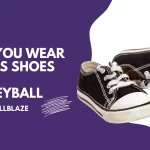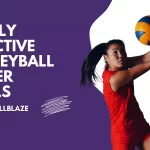For a volleyball defender to maximize his or her chances of making great defensive plays, he or she must maintain the right attitude at all times.
Having natural talent and repetition clearly helps a player become a good defender, but it is having the right mindset that sets great defenders apart from merely good ones.
An excellent understanding of every game situation, coupled with a confident, aggressive attitude that fosters the belief that one will be able to get to every ball, constitutes the right mindset.
What is the Mindset of a Great Volleyball Defender?

Not being ready for the ball when it comes to you is one of the most frustrating things about volleyball, not only for your coach and teammates but also for you. It is important to keep these points in mind when you are hit, so you don’t get surprised when you’re hit:
- Anticipate the outcome of the play and how the ball will be handled
- Determine which players have power and finesse hitters in their lineup? Power hitters can sometimes turn into finesse hitters and vice versa?
- What are the favorite shots of each opposing player?
- Keep an eye on the hitter’s shoulder position to determine where the ball will go
- You can again determine where the ball is going by looking into the hitter’s eyes
Having such a deep understanding of the game will allow you to make up for not being as naturally athletic and not being able to get to the ball as quickly as others may be able to do so by putting yourself in the right place at the right time.
An Aggressive, Confident Attitude
A negative attitude constantly getting under players’ skin is not what we mean by having an aggressive attitude. The opposite is true; we mean that you have a positive attitude, even if you don’t seem to be able to catch every ball.
Energizer Bunnies on the court should never give up, much to the surprise of their opponents who think they have a much tougher time beating someone with such a positive attitude.
In addition to being aggressive, you must also be confident. Aggressive play on court breeds confidence, which is a great benefit. Your confidence skyrockets when you know your coach, teammates, and fans appreciate everything you do, especially when you go after every ball and make a few great defensive plays.
You may enjoy reading Grass Volleyball Court Dimensions
Size Up Your Opponent
Prior to each serve or receive, determine the number of front row hitters and the position of the setter across the net.
The next step is to watch how the ball is PASSED. More often than not, the quality of the pass will provide wonderful clues as to what type of set will be made, in which part of the court, or by which hitter.
Balls that are passed behind the 10-foot line are usually set at an angle to the Left Front or Right Front; therefore, the attack is typically angled. The process of “Reading the Hitter” is one of elimination.
We are now ready to begin the SET. The setter should be your first priority. It will be easier to determine whether he/she jumps for a set or a potential attack if you already know where he/she is located in the row. What is the setter’s favorite ball to attack when he or she is on the front row? In this position, reading a left-handed setter is harder than reading a right-handed setter.
Attackers’ Body Language
When the Setter doesn’t attack the set, you should focus on the likely hitter. Be careful when approaching! Generally, aggressive approaches result in aggressive attacks while slower approaches usually result in off-speed shots (rolls, soft, deep placements, or tips). Watch out for an off-speed shot if you don’t see a complete approach.
A spiker’s approach angle and where his shoulders are facing give away where he is going to hit the ball. An attacker in position 4 on the Left Front can be used as an example.
She will typically attack from a cross-court angle if she approaches from outside the court. Watch for line shots or centers of the court to be attacked if the attacker approaches inside the sideline near the 10-foot line. Consider the attacker’s shoulders and feet after determining the angle of approach.
Down the line shots are expected when the shoulders and feet are pointing toward the net. In this case, expect a cross-court shot if they are angled towards the net post. Attackers’ balls tend to travel in the direction in which they set up their feet. Due to a set being too far off or too tight to the net, an attacker will often adjust their approach and try to keep the ball in play, which usually means crossing court where there is more room to do so.
Take a look at the hitter’s armswing next. It is also possible to determine the type of shot by looking at the elbow and hand. A tip or roll shot is most likely if the elbow drops into the “shot put” position.
Is the attacker’s hand visible to you? It is likely that you cannot see the hand during a fast armswing that results in a hard attack due to everything being so fast. In this case, you should expect off-speed shots if you can see the attacker’s hand.
You may enjoy reading How Tall Are Liberos In Volleyball?
Location of the Set

Depending on where the set is located, the hitter’s shot selection is often limited. In terms of options, an outside hitter will have the most flexibility if he or she sets near the antenna and about 2-3 feet off the net.
He or she will have the most control with a wide range of options. In tight sets, the ball is more likely to be driven heavily and shallowly if there is no block up, and at an angle if there is. Line shots are more likely to occur the closer the ball is to the antenna. The set will cross court sharply near the 10-foot line if it is outside the antenna. Expect a deep ball to be hit at an angle if the ball is set off the net.
Off-speed shots are often the result of the ball being set behind the hitter or the hitter approaching too far under the ball. When a low inside set ball is hit, it typically leads to an angled shot (like a 31 or shoot). Sets outside the antenna or passed up by the hitter typically go back to the RB.
Location of the Block
The blocking strategy of each team must be understood by all defenders. A blocking strategy generally involves forcing your opposition to hit the ball at your strongest defenders, including yourself, so that you can force them to miss.
You cannot see the hitter if you stand directly behind your blockers. Knowing where an attacker is aiming depends on their body language and approach (sometimes even their eyes). Over the block soft shots should be covered by a defender.
Communicate if your blockers are blocking line or angle, allowing the defense behind them to be better positioned or anticipate possible holes in the block if they are blocking both.
Defending yourself begins with a block. When the blocker receives the pass to the setter, his or her eyes should focus on the attacker to determine his/her approach angle.
After establishing their position and jumping, their eyes should return to the ball. When the hitter jumps, blockers need to take note of the direction in which the attacker is facing as well as their shoulders and arms.
By lining up with the attacker’s hitting shoulder and where the ball is likely to cross the net, Blockers need to learn to read the approach and front the hitter. The opposing team’s left-handed hitters should be observed during warm-ups.
You may enjoy reading Can You Set in Beach Volleyball?
Technique of Defender
It is very important for the Defender to start from the right position. Weight should be leaning forward up on the toes with feet slightly more than shoulder width apart. Players should move in any direction with one foot slightly in front of the other.
Players should have their arms and hands out in front of them and apart so that they can run then dig from the platform they have created. In order to absorb some of the ball’s force, the player should relax his or her arms back toward the body a little at contact.
It is always better to stay on your feet and use two hands as much as possible as a defender. Overhand digging should be used if the ball is hit straight at the defender’s face.
Defenders are always trying to get the ball up. The key to becoming a good defender is good technique and never giving up. Getting to the ball and making it playable includes:
- Sprinting
- Taking quick shuffle steps
- Lunging
- Diving
- Rolling
- Sprawling
- Jumping
If the ball is far away, you have to take the right attitude – you have to think “I can get it.” Charge the ball with two arms and try to lift it up by snapping your forearm. Set the ball up for a teammate by getting the ball to the middle of the court. Staying under the ball and controlling it will be easier if the ball is played low.
Mindset of the Great Defender

In order to be a great defender, one must first become a great reader. A great defender should always expect the ball to be available to him or her. Having the attitude of being able to get to any ball and pursuing it relentlessly is essential.
Don’t be surprised when balls are hit hard your way – expect it and don’t be caught off guard! Make sure you are in good court position for the hard attack (so you can react quickly to a hard hit ball) and then get ready for the off-speed shot (so you are in a low-ready position to react to an off-speed shot).
To beat the ball to its destination, you must always be ready to move. By getting every ball up, try to get into the attacker’s head and frustrate them. By popping up your best shot, you can control your attacker’s best shot.
In order to be a good defender, you must study, discipline, and be patient. Take the time to study the opponent. Stay disciplined and learn the clues. Make sure your teammates cover their areas as well. In terms of tactics and strategies, the following are some of the most important:
- Challenge the heat while staying in the angle
- Hide your defense in a variety of ways to confuse your attacker
- The ball is being charged
- Assessing the opponent’s hitter by listening to their calls (line and/or hole)
You may enjoy reading How To Increase Your Vertical For Volleyball?
Training the Defender
A coach or hitter should start with some basic drills and a digger should be in Left Back across the net with a coach up on a box in Left Front. By hitting hard, then soft, then tip and roll shots to the digger, the hitter can make the defender read body, armswing, and hand contact clues. Start mixing up the attacks as soon as the digger understands.
As well as moving the coach and hitter around to the middle and right front, make sure the digger is in different positions. Tossing the ball at a realistic, game-like height is essential to “duplicate” a hitter’s motion as accurately as possible.
Adding a live hitter that self-tosses and attacks about five feet off the net as soon as possible will make the game more exciting. To read an attacker’s approach and time his jump or swing, repeat the above. Another hitter should be added, with one in the left front and one in the right front. Alternate between hitters and attackers at the end.
Hit & Dig: Using two diggers and two hitters on the court, repeat the above, so now the defenders must communicate and decide who is going to hit, where the attacker will hit, and who will be playing the ball.
The attackers should take 10 attacks, and the diggers should count how many balls they reach the middle. Two hitters and one digger will challenge the diggers’ range.
No Blocking Drills: Set the ball five feet off the net and do some of your normal wash drills without blocking. By doing this, your defense will be forced to read hitters more carefully, while the hitters will be forced to practice out-of-system attacks.
It is important to do most drills WITH a blocker at the net unless your team does not block. That will give your defenders a better understanding of what they will see on match day!
Conclusion
Learning how to develop great court sense is crucial to becoming a great reader. You can learn the most from the game if you play it. Good positioning is key to good defense. First, you need to anticipate, then you need to be able to read.
As a way to read the hitter, you have to consider the hitter’s shots, the attacker’s approach line, his body language, and his armswing. A great defender always wants the ball, and attitude is everything!
You may enjoy reading Why Do Volleyball Players Wear Leggings?





